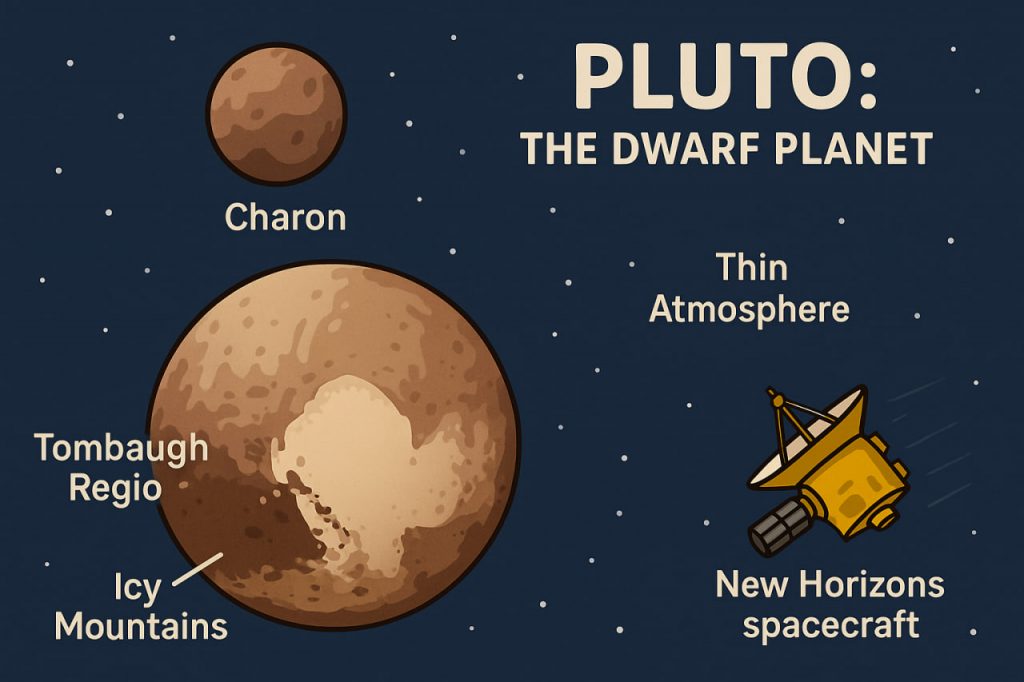Pluto, once considered the ninth planet, is now classified as a dwarf planet in the Kuiper Belt—a region of icy bodies beyond Neptune. Despite its small size, Pluto has captured the fascination of scientists and the public alike with its dynamic surface, possible subsurface ocean, and complex interaction with its moon Charon.
Basic Characteristics of Pluto
- Distance from the Sun: ~5.9 billion km (39.5 AU)
- Diameter: ~2,377 km (about two-thirds the width of the Moon)
- Orbital period: ~248 Earth years
- Day length: ~6.4 Earth days
- Surface temperature: ~ -229°C (-380°F)
- Atmosphere: Thin and made mostly of nitrogen, with traces of methane and carbon monoxide
- Moons: 5 known — Charon (largest), Styx, Nix, Kerberos, and Hydra
Why Pluto Is Not a Planet
In 2006, the International Astronomical Union (IAU) redefined what it means to be a planet. According to the new definition, a planet must:
- Orbit the Sun
- Be spherical in shape
- Clear its orbit of other objects
Pluto meets the first two criteria but fails the third because it shares its orbit with other Kuiper Belt objects. Hence, it was reclassified as a dwarf planet.
Surface and Composition
Pluto has a surprisingly geologically active surface, with:
- Mountains made of water ice
- Plains of frozen nitrogen
- A heart-shaped region called Tombaugh Regio
- Possible cryovolcanoes (ice volcanoes)
These features suggest that Pluto is not a dead world but has experienced internal and surface changes over time.
Pluto and Charon: A Binary System?
Charon, Pluto’s largest moon, is about half its size—so large that the two bodies actually orbit a common center of gravity outside Pluto itself. This unique setup has led astronomers to consider them a binary system.
Charon’s surface shows deep canyons and dark polar caps, and it may have once had an internal ocean as well.
The Atmosphere
Pluto’s thin atmosphere expands and contracts as it moves closer to or farther from the Sun. As Pluto warms, frozen gases sublimate into gas, forming a hazy atmosphere. When it moves farther away, the atmosphere may freeze back onto the surface.
Exploration: The New Horizons Mission
NASA’s New Horizons spacecraft made a historic flyby of Pluto in July 2015, providing the first close-up images and revealing Pluto’s:
- Active geology
- Complex atmosphere
- Ice flows and towering mountains
This mission revolutionized our understanding of Pluto and sparked renewed interest in the outer Solar System.
Pluto’s Place in the Solar System
Though it’s no longer officially a planet, Pluto plays a vital role in helping scientists:
- Understand the formation of icy bodies
- Study planetary evolution in the outer Solar System
- Explore conditions in the Kuiper Belt and beyond
Conclusion
Pluto may be small, but it’s a world full of surprises. Its icy mountains, dynamic atmosphere, and relationship with Charon show that even the smallest bodies can be complex and fascinating. As exploration of the outer Solar System continues, Pluto remains a symbol of discovery and curiosity.
Glossary
- Dwarf Planet: A celestial body that orbits the Sun and is spherical but hasn’t cleared its orbit
- Kuiper Belt: A region of icy bodies beyond Neptune
- Cryovolcano: A volcano that erupts water, ammonia, or methane instead of lava
- New Horizons: NASA mission that flew past Pluto in 2015
- Sublimation: When a solid turns directly into a gas without becoming liquid


